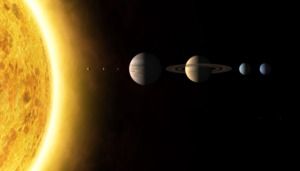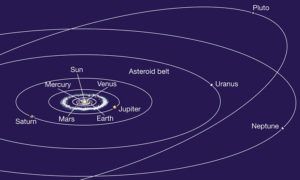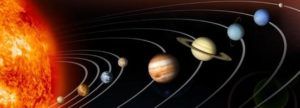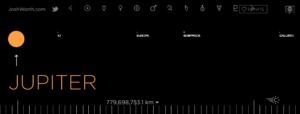This foldable bike helmet can fit into a water bottle.
Posted in transportation
Rice University computer scientists have adapted a widely used technique for rapid data lookup to slash the amount of computation — and thus energy and time — required for deep learning, a computationally intense form of machine learning.
“This applies to any deep-learning architecture, and the technique scales sublinearly, which means that the larger the deep neural network to which this is applied, the more the savings in computations there will be,” said lead researcher Anshumali Shrivastava, an assistant professor of computer science at Rice.
The research will be presented in August at the KDD 2017 conference in Halifax, Nova Scotia. It addresses one of the biggest issues facing tech giants like Google, Facebook and Microsoft as they race to build, train and deploy massive deep-learning networks for a growing body of products as diverse as self-driving cars, language translators and intelligent replies to emails.
A study by neuroscientists at Toronto-based Baycrest Rotman Research Institute and Stanford University involving playing a musical instrument suggests ways to improve brain rehabilitation methods.
In the study, published in the Journal of Neuroscience on May 24, 2017, the researchers asked young adults to listen to sounds from an unfamiliar musical instrument (a Tibetan singing bowl). Half of the subjects (the experimental group) were then asked to recreate the same sounds and rhythm by striking the bowl; the other half (the control group) were instead asked to recreate the sound by simply pressing a key on a computer keypad.
I’m super excited to share a (via NowThis Op-Ed) video of my bipartisan plan to fund a Basic Income, which I call a Federal Land Dividend. This is a main platform issue of my California Libertarian Governor run. This plan can forever end poverty and lack of health care in California and America—and perhaps even end poverty and lack of health care around the world if adopted by foreign governments.
This futurist has a plan to bring basic income to America.
June 6 (UPI) — Our galaxy and its neighbors exist in a sort of cosmic void, research suggests. The latest analysis supports the conclusion of a 2013 study which showed the Milky Way exists in a region of the universe sparsely populated by galaxies, stars and planets.
The new research — presented this week at the annual American Astronomical Society meeting — also helps bridge the divide between astronomers torn by competing measurements of the Hubble Constant, the rate at which the universe is expanding.
Different groups of astronomers have developed different techniques for measuring the Hubble Constant, with each method yielding different numbers.
Due technical issues the Longevity Panel with Aubrey de Grey, Alexandra Stolzing and Oliver Medvedik + guests will be airing on Friday 9th June at 13:00 on the MMTP Facebook page. Apologies for the delay.
We are teaming up with LEAF/Lifespan.io for our Longevity Panel with Dr. Alexandra Stolzing, Dr. Aubrey de Grey, Dr. Oliver Medvedik and a number of other guests. We will be streaming the panel live to this page and we invite you to join us. It will also be made available later to view on Youtube.
This was originally scheduled for the 6th June but had to be rescheduled due to technical problems. We apologize for the inconvenience.
The performance of humans’ puny brains will be outmatched by computers within just 13 years, billionaire Elon Musk has claimed.
The Tesla and SpaceX founder said that artificial intelligence will beat us at just about everything by 2030.
He made the comments on Twitter, where he was responding to a new study which claims our race will be overtaken by 2060.
 What’s wrong with this illustration of the planets in our solar system? »
What’s wrong with this illustration of the planets in our solar system? »
For one thing, it suggests that the planets line up for photos on the same solar ray, just like baby ducks in a row. That’s a pretty rare occurrence—perhaps once in several billion years. In fact, Pluto doesn’t even orbit on the same plane as the planets. Its orbit is tilted 17 degrees.  So, forget it lining up with anything, except on rare occasions, when it crosses the equatorial plane. On that day, you might get it to line up with one or two planets.
So, forget it lining up with anything, except on rare occasions, when it crosses the equatorial plane. On that day, you might get it to line up with one or two planets.
But what about scale? Space is so vast. Perhaps our solar system looks like this ↓
No such luck! Stars and planets do not fill a significant volume of the void. They are lonely specs in the great enveloping cosmic dark.*  Space is mostly filled with—well—space! Lots and lots of it. In fact, if Pluto and our own moon were represented by just a single pixel on your computer screen, you wouldn’t see anything around it. Even if you daisy chain a few hundred computer screens, you will not discern the outer planets. They are just too far away.
Space is mostly filled with—well—space! Lots and lots of it. In fact, if Pluto and our own moon were represented by just a single pixel on your computer screen, you wouldn’t see anything around it. Even if you daisy chain a few hundred computer screens, you will not discern the outer planets. They are just too far away.
Josh Worth has created an interactive map of our solar system. For convenience, it also assumes that planets are lined up like ducks. But the relative sizes and distance between planets are accurate. Prepare to change your view of the cosmos…

Just swipe your finger from the right edge of the screen to move away from the sun. Despite a fascinating experience (and many cute, provocative Easter eggs hidden between the planets), few readers swipe all the way out to Pluto and the author credits. On my high-resolution monitor, it requires more than a thousand swipes. Imagine if the Moon had been more than 1 pixel…It would take a long, long time! I would rather go out to dinner and a movie. But I urge you to travel at least to Jupiter. At 1/7 of the trip to Pluto, it should take less than 5 minutes.
On this scale, you won’t see the 1½ or 2 million asteroids between Mars and Jupiter. They aren’t large enough to merit a pixel. As Josh states, “Most space charts leave out the most significant part – all the space.” (an Easter egg at 1.12 billion km on the map).
* I borrowed this phrase from my former Cornell professor, Carl Sagan. He uses it in Pale Blue Dot [timestamp 2:14.]. This video tribute became a touchstone in my life; even more than having Sagan as a professor and mentor.
If you view it, be sure to also view Consider Again, Sagan’s follow-up in the video below. It is a thought-provoking observation of human-chauvinism throughout history—even among ancient Greeks. Carl isn’t the first atheist, of course. But he is eloquent in describing mankind’s ego trip: The delusion of a privileged place in the universe, or the religious depiction of God and his relationship with our species.
Related:
Credit: ▪ Josh Worth and Sachin Gadhave who offers an illustrative answer at Quora.com
Philip Raymond co-chairs Crypsa & Bitcoin Event, columnist & board member at Lifeboat, editor
at WildDuck and will deliver the keynote address at Digital Currency Summit in Johannesburg.